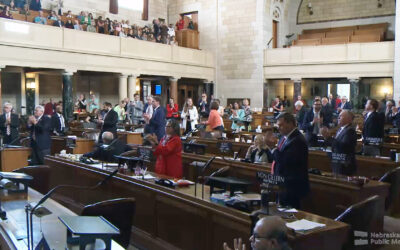What is the Child Care Development Block Grant?
The Child Care Development Block Grant (CCDBG), initiated in 1990 and reauthorized in 2014, is the primary source of federal funding for child care assistance to states. Federal and state dollars provide subsidies for eligible low-income families, working or going to school, with children under age 13. Most children served through CCDBG are under age 5 and need full-day, year-round care so their parents can remain in the workforce. Broad federal guidelines are to: 1) strengthen health and safety requirements for providers; 2) improve transparency to help families make informed choices regarding care; and 3) enhance the quality of child care. States have flexibility within these guidelines to determine their own policies regarding provider rates, family eligibility and other provisions to implement the program.
Nebraska’s Child Care Development Block Grant Regulations
The Nebraska Department of Health and Human Services (NDHHS) administers the CCDBG for the state. Every two years, states submit a plan to the federal government outlining their policies for program implementation. The current child care policies are effective through Sept. 30, 2021, and define such aspects as required provider training, reimbursement rates, billing practices, enrollment requirements of special populations and family eligibility criteria. Until the CCDBG Reauthorization in 2014, the child care subsidy program was intended primarily to serve as a work support for low-income parents. Recent developments, however, encouraged states to address quality standards for child development in addition to basic health and safety requirements. This is a significant change in the program and is a fundamental shift toward improved outcomes for children.
Nebraska Standards for Quality Child Care Environments
The most recent regulatory and legislative changes in CCDBG recognize the addition of child development standards by focusing on improving provider qualifications and developing guidelines that encourage continuity of care for children. Disincentives to accepting subsidy include a number of issues that can directly affect the financial viability of providers including:
- Timeliness of reimbursement: It takes 30 to 60 days after child care services have been delivered for providers to receive subsidy reimbursements, which puts a severe financial strain on these professionals.
- Cost of quality: Subsidy reimbursement rates do not cover the cost of high-quality services known to promote child development.
- Attendance-based reimbursement: Providers are required to keep a slot open whether the subsidy-eligible child is there or not; however, providers can only bill for reimbursement if the child is in attendance. While NDHHS has recently allowed providers to bill up to five days of absences per month, attendance-based billing can create significant financial difficulties for child care programs.
CCDBG Under COVID-19
Maintaining child care openings during the pandemic has become a critical challenge for providers and an access issue the working parents who depend upon child care programs. A recent Executive Order (EO 20-08) temporarily provides for the usage of enrollment-based reimbusement policies, representing a step in the right direction. Nevertheless, additional state government supports are needed. As we look to the additional funding resources provided to the CCDBG program through the federal CARES Act to help sustain Nebraska's child care system, it will be necessary to think strategically and carefully about how best to organize our available resources in the interests of children, working parents and the professional early childhood workforce as a whole.


